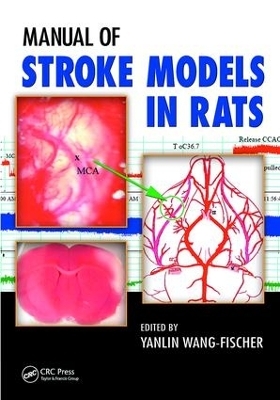
Manual of Stroke Models in Rats
CRC Press (Verlag)
978-1-138-40989-7 (ISBN)
During the last few years, exciting new insights into mechanisms and treatment of stroke have been obtained from animal experiments. Hence, the use of animal models to induce stroke are of paramount importance as research tools. While a few articles on this topic have been published in select journals, until now there has not been a systematic technical book available which assists researchers in building upon commonly known knowledge.
The Manual of Stroke Models in Rats explains in great detail the methods and techniques for accomplishing different stroke models in rats, as well as some techniques using mice. Expert contributors to this text include the most recent research information available, as well as generally recognized facts, making this volume an imperative tool for those researchers seeking to identify new areas of exploration.
The first text in 20 years to detail new techniques in rat stroke models
The book begins with a statistical update of stroke in America, and proceeds to discuss the rationale for using ischemic stroke models. Major sections include different surgical models of stroke induced by the occlusion of the distal middle cerebral artery, by intraluminal filament or embolic implantation, by photochemically induced thrombosis, global cerebral ischemia induced by asphyxia cardiac arrest or by four-vessel occlusion, and brain hemorrhage. The book also includes anesthesia procedures, general principles of microsurgery, and a study of microsurgical instruments. Numerous tables, figures, and color images are used to supplement the material.
The editor, Dr. Yanlin Wang-Fischer, has published more than 40 scientific articles in various medical journals and contributed to several projects related to animal models and surgeries. In this volume, she brings together contributors who represent the cutting edge of research in the field. By reviewing the methods in this detailed technical treatise, research
Yanlin Wang-Fischer, M.D., Ph.D., is a neuropharmacologist. She has worked in the pharmaceutical industry and academic environment for many years. Dr. Wang-Fischer earned her bachelor’s degree and doctor of medicine at Hunan Medical University, Changsha, China. Following clinical fellowship training in cardiovascular and metabolic diseases at Hunan Medical University, where she became an attending physician, she earned her Ph.D. in 1994. She completed her postdoctoral fellowship training at the School of Medicine at Laval University and at Boston University. Dr. Wang-Fischer joined the Howard Hughes Medical Institute at Yale University, New Haven, Connecticut, in 2000. She has contributed to several projects related to animal models and surgeries and produced an instructional video on studies of animals in vivo for new trainees. In 2002, Dr. Wang-Fischer joined the team of neurological disorders at Johnson & Johnson PRD, Raritan, New Jersey. She led projects based on different animal models to discover new drugs for treatment of stroke and neurological diseases. In 2006, Dr. Wang-Fischer joined Palatin Technologies and oversees projects on nasal and cerebral drug delivery. She has developed a novel technique to quickly assess nasal tolerance. Dr. Wang-Fischer has published more than 40 scientific articles in prestigious medical journals. Her current interests include neurological, cardiovascular, metabolic, and inflammatory diseases, mainly concerned with physiology and pharmacology in vivo.
Preface, About the Editor, Contributors, Chapter 1 Statistical Update of Stroke in America, Chapter 2 Rationale for Using Ischemic Stroke Models, Chapter 3 Animal Models of Ischemic Stroke: A Historical Survey, Chapter 4 Anatomy and Cerebral Circulation of the Rat, Chapter 5 Which Animal to Choose?, Chapter 6 Which Model to Use?, Chapter 7 Failure Is the Mother of Success: Why Neuroprotective Therapies That Work in Laboratories Fail in Clinical Trials, Chapter 8 Anesthesia of Laboratory Rats, Chapter 9 General Principles of Microsurgery on Animals, Chapter 10 Microsurgical Instruments for Stroke Studies, Chapter 11 Postoperative Care, Chapter 12 Surgery Procedure for Distal Middle Cerebral Artery Occlusion Model, Chapter 13 Surgical Models of Stroke Induced by Intraluminal Filament Implantation, Chapter 14 Embolic Stroke Models, Chapter 15 Photochemically Based Models of Focal Experimental Thrombotic Stroke in Rodents, Chapter 16 Induction of Asphyxia Cardiac Arrest in a Rat as a Model of Global Cerebral Ischemia, Chapter 17 Four-Vessel Occlusion Stroke Model in Rats, Chapter 18 Brain Hemorrhage Models in Rodents, Chapter 19 Endpoints for Stroke Studies, Chapter 20 Tissue Staining Techniques for Stroke Studies, Chapter 21 Protocol for Brain Vessel Corrosion Casting and Embedding, Chapter 22 Magnetic Resonance Imaging in Stroke Study, Chapter 23 Administration of Substances and Sampling, Chapter 24 Study Design in Animal Models of Stroke, Chapter 25 Common Biochemical and Physiological Parameters in Rats, Index
| Erscheinungsdatum | 08.06.2022 |
|---|---|
| Verlagsort | London |
| Sprache | englisch |
| Maße | 178 x 254 mm |
| Gewicht | 453 g |
| Themenwelt | Medizin / Pharmazie ► Allgemeines / Lexika |
| Medizinische Fachgebiete ► Innere Medizin ► Kardiologie / Angiologie | |
| Naturwissenschaften ► Biologie ► Humanbiologie | |
| Naturwissenschaften ► Biologie ► Zoologie | |
| ISBN-10 | 1-138-40989-8 / 1138409898 |
| ISBN-13 | 978-1-138-40989-7 / 9781138409897 |
| Zustand | Neuware |
| Haben Sie eine Frage zum Produkt? |
aus dem Bereich


